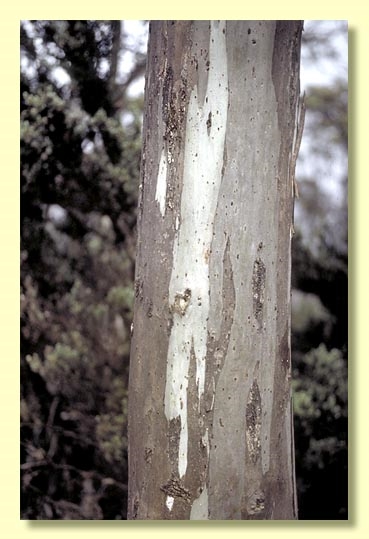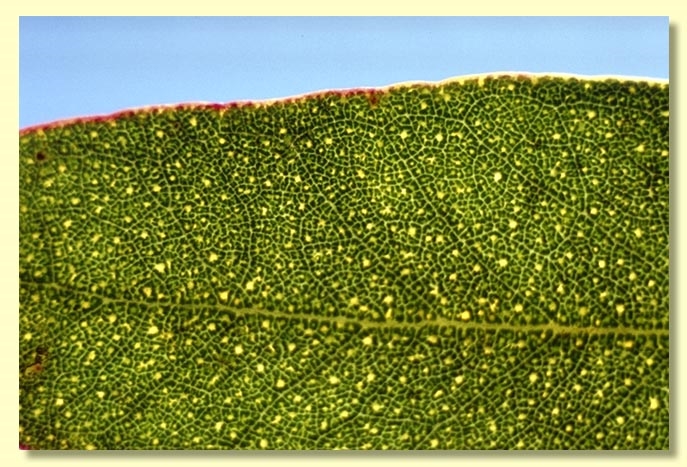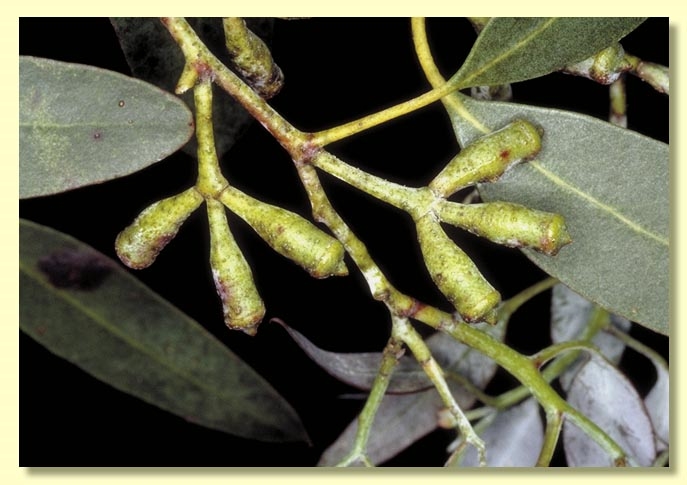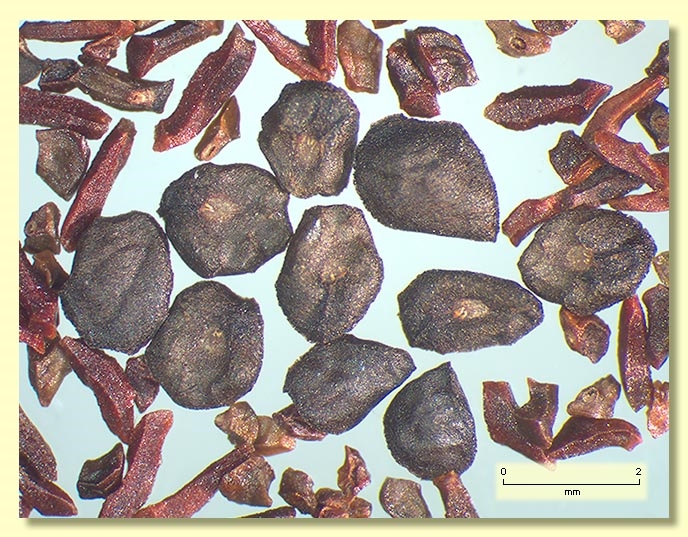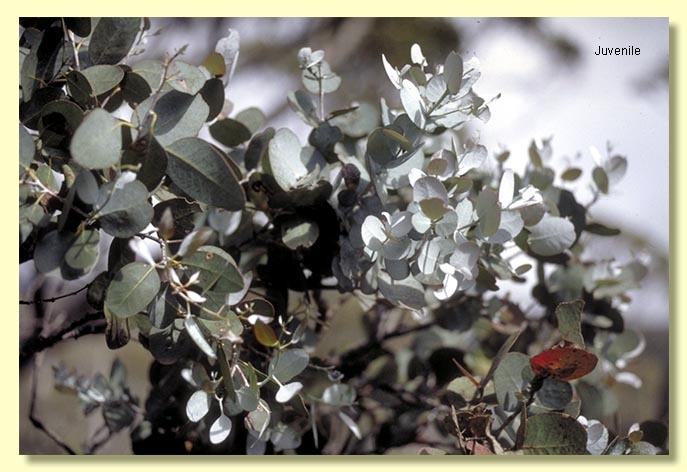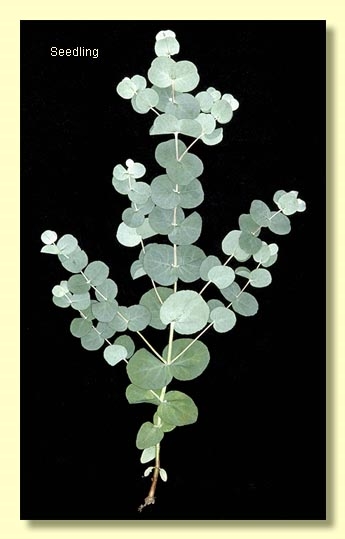Euclid - Online edition
Eucalyptus urnigera
Eucalyptus | Symphyomyrtus | Maidenaria | Euryotae | Orbiculares
Eucalyptus urnigera Hook.f., London J. Bot. 6: 477 bis (1847).
T: Mt Wellington, Tas., 9 Feb. 1839, R.C.Gunn 1074/1842; Lectotype: K000279742; isolectotypes: BM000796087; NSW313892; NSW313894; fide A.R. Bean Telopea 12: 519 (2010).
Eucalyptus urnigera var. elongata Rodway, Tasmanian Fl. 58 (1903). T: not designated.
Bark smooth throughout or rarely with some rough strips retained at base of larger trunks; smooth bark mottled light grey, white, yellow, brown, pink and green; branchlets glaucous.
Juvenile growth (coppice or field seedlings to 50 cm): stem rounded in cross-section, glaucous; juvenile leaves opposite and sessile for many pairs becoming alternate in late juvenile phase, orbicular to cordate, 1.2–2.8 cm long, 1.3–2.8 cm wide, amplexicaul, margin crenulate, glaucous.
Crown more or less glaucous.
Adult leaves alternate, petiole 0.7–3 cm long; blade broadly lanceolate to lanceolate or elliptical, 3.5–9 cm long, 1–2.8 cm wide, base tapering to petiole, margin entire or subcrenulate, concolorous, at first dull and glaucous, weathering glossy, green, side-veins greater than 45° to midrib, densely to very densely reticulate, intramarginal vein well removed from margin and looped, oil glands mostly intersectional.
Inflorescence axillary unbranched, pendulous, peduncles 0.5–2.5 cm long, buds 3 per umbel, pedicels 0.1–1.3 cm long. Mature buds cylindrical but hypanthium narrowed below join with operculum, 1–1.3(1.7) cm long, 0.5–0.7 cm wide, very glaucous, scar present, operculum short, flattened and beaked, stamens inflexed, anthers cuboid to oblong, versatile, dorsifixed, dehiscing by longitudinal slits (non-confluent), style long, stigma blunt, locules 3 or 4, the placentae each with 4 or 6 vertical ovule rows. Flowers white.
Fruit on pedicels 0.1–1 cm long, urceolate, 0.9–1.5 cm long, 0.6–1.1 cm wide, often glaucous, disc descending, valves 3 or 4, enclosed.
Seeds dark brown, grey or black, 1.5–2.5 mm long, ovoid or depressed-ovoid to almost cuboid, sometimes lacunose, dorsal surface smooth or shallowly pitted, hilum ventral.
Cultivated seedlings (measured at ca node 10): cotyledons bilobed; stems rounded to square in cross-section, glaucous, warty or smooth; leaves sessile, opposite for many pairs, orbicular to cordate, 1.5–3.5 cm long, 1.7–3.5 cm wide, base usually amplexicaul, margin entire or crenulate, apex rounded to emarginate, glaucous weathering to grey-green.
Flowering has been recorded in all months of the year with a peak from April to July (see Williams & Potts, 1996, p. 116).
A small to medium-sized tree endemic to Tasmania where it only occurs at mid to high altitudes in the south-east, e.g. Mt Wellington and Mt Field National Park, but disjunct occurences are also found West of Lake Sorrel, in the Midlands on Mount Seymour, on Maria Island and near Strathport on Tylers Hill.
Eucalyptus urnigera is distinguished most easily by the pendulous, urn-shaped fruit which resemble no other in Tasmania. Bark is smooth, the crown usually glaucous at higher altitudes, greener at lower altitudes, and buds and fruit are in threes. It is perhaps most closely related to E. morrisbyi, a species endemic and restricted to the Cremorne–South Arm area and Risdon area east of Hobart. E. morrisbyi differs in being, relative to E. urnigera, a more lowland species with less pendulous and smaller buds and fruit.
Eucalyptus urnigera belongs in Eucalyptus subgenus Symphyomyrtus section Maidenaria, a large group of species more or less restricted to south-eastern Australia, characterised by bilobed cotyledons, simple axillary inflorescences, buds with two opercula, stamens with versatile anthers and flattened seeds with a ventral hilum. Within this section, E. urnigera, with nine other species, forms series Orbiculares having orbicular to cordate juvenile leaves opposite for many nodes, a glaucous crown, and buds in threes. Series Orbiculares is confined to cool-temperate parts of far south-eastern New South Wales, eastern Victoria and Tasmania and includes these species: E. urnigera, E. morrisbyi, E. gunnii, E. archeri, E. cordata, all endemic to Tasmania, E. perriniana (New South Wales, Victoria and Tasmania); E. glaucescens, E. chapmaniana (New South Wales, Victoria), E. saxatilis (endemic to Victoria), and E. pulverulenta (endemic to New South Wales).


